Spatial Distribution Characteristics of Soil Salinity and Moisture and Its Influence on Agricultural Irrigation in the Ili River Valley, China
Abstract
1. Introduction
2. Literature Review
3. Materials and Methods
3.1. Study Area
3.2. Sample Collection and Analysis Methods
3.3. Methodology
3.3.1. Geostatistical Analysis
3.3.2. Geographical Detector
Extraction of Model Factors
Geographical Detector Model
3.4. Data Analysis and Processing
4. Results
4.1. Statistical Characteristics of Soil Salinity and Moisture
4.2. Spatial Variability of Soil Salinity and Moisture
4.3. Spatial Pattern of Soil Salinity and Moisture
4.4. The Driving Factors of the Spatial Distribution of Soil Salinity and Moisture
4.5. The Interaction of Driving Factors
5. Discussion
6. Conclusions
- (1)
- The average value of soil salinity and soil moisture were 0.1345% and 0.6082%, respectively, and mainly lightly salinized soil was distributed in the study area. The coefficient of variation of soil salinity and water content was 71.25% and 31.89%, respectively, which corresponds to moderate levels of variation. There were moderate spatial auto-correlation of both soil salinity and moisture, which were mainly affected by structural (topography, soil types, parent material, climate, etc.) and random (irrigation, fertilization, farming methods, planting crops, and cropping system, etc.) factors.
- (2)
- Spatially, in terms of spatial distribution, soil salinity in the southwest was higher than in the northeast, and the high content center was concentrated in the south of the study area. Soil moisture was relatively high in the middle and along the north eastern edge, while soils in the northwest and southeast have relatively low moisture.
- (3)
- Available phosphorus, organic matter and roughness of terrain were the main driving factors of the spatial distribution of soil salinity. Alkaline nitrogen, available phosphorus, available potassium and elevation were the main driving factors of the spatial distribution of soil moisture. The interaction of available potassium with aspect and roughness of terrain played a dominant role in the spatial distribution of soil salinity, and the effect of available potassium depended on the aspect and roughness of terrain. The interaction of organic matter with available potassium and alkaline nitrogen played a leading role in the spatial distribution of soil moisture, and the explanatory power of organic matter was only strong when interacting with available potassium and alkaline nitrogen under certain conditions. Therefore, combined action of topographic factors and soil nutrients has a major influence on the spatial distribution of soil salinity and moisture.
- (4)
- Our results obtained this study indicate that an effective way to improve the degree of soil salinization is to make a suitable fertilization system under different topography conditions. First of all, we suggest that popularizing water-saving irrigation technology, controlling irrigation quota, digging drainage ditch, implementing the paddy-wheat rotation, and changing the backward situation of flood irrigation in the areas with a high salt salinity content. Secondly, in the region with high slope and low altitude, the amount of specific soil nutrient elements should be appropriately increased to improve soil fertility. Finally, when it comes to nutrient management, managers need to consider the impact of topographic factors and soil nutrient on the distribution of soil salinity and moisture, expand the scope of scientific research, training and promotion, then scientifically guide farmers to carry out rational fertilization and improve crop yield. Additionally, some measures such as improvement of irrigation and drainage system, rational exploitation and utilization of groundwater, and water-saving irrigation can also effectively improve soil salinization.
Author Contributions
Funding
Conflicts of Interest
References
- Li, J.; Pu, L.; Han, M.; Zhu, M.; Zhang, R.; Xiang, Y. Soil salinization research in China: Advances and prospects. J. Geogr. Sci. 2014, 24, 943–960. [Google Scholar] [CrossRef]
- Jiang, S.-Q.; Yu, Y.-N.; Gao, R.-W.; Wang, H.; Zhang, J.; Li, R.; Long, X.-H.; Shen, Q.-R.; Chen, W.; Cai, F. High-throughput absolute quantification sequencing reveals the effect of different fertilizer applications on bacterial community in a tomato cultivated coastal saline soil. Sci. Total Environ. 2019, 687, 601–609. [Google Scholar] [CrossRef]
- Ma, Z.; Xu, Y.; Peng, J.; Chen, Q.; Wan, D.; He, K.; Shi, Z.; Li, H. Spatial and temporal precipitation patterns characterized by TRMM TMPA over the Qinghai-Tibetan plateau and surroundings. Int. J. Remote Sens. 2018, 39, 3891–3907. [Google Scholar] [CrossRef]
- Bui, E.N. Soil salinity: A neglected factor in plant ecology and biogeography. J. Arid Environ. 2013, 92, 14–25. [Google Scholar] [CrossRef]
- Metternicht, G.I.; Zinck, J.A. Remote sensing of soil salinity: Potentials and constraints. Remote Sens. Environ. 2003, 85, 1–20. [Google Scholar] [CrossRef]
- Cemek, B.; GÜLer, M.; KiliÇ, K.; Demir, Y.; Arslan, H. Assessment of spatial variability in some soil properties as related to soil salinity and alkalinity in Bafra plain in northern Turkey. Environ. Monit. Assess. 2007, 124, 223–234. [Google Scholar] [CrossRef]
- Moustafa, M.M.; Yomota, A. Use of a covariance variogram to investigate influence of subsurface drainage on spatial variability of soil-water properties. Agric. Water Manag. 1998, 37, 1–19. [Google Scholar] [CrossRef]
- Zhang, W.-T.; Wu, H.-Q.; Gu, H.-B.; Feng, G.-L.; Wang, Z.; Sheng, J.-D. Variability of Soil Salinity at Multiple Spatio-Temporal Scales and the Related Driving Factors in the Oasis Areas of Xinjiang, China. Pedosphere 2014, 24, 753–762. [Google Scholar] [CrossRef]
- Peng, J.; Biswas, A.; Jiang, Q.; Zhao, R.; Hu, J.; Hu, B.; Shi, Z. Estimating soil salinity from remote sensing and terrain data in southern Xinjiang Province, China. Geoderma 2019, 337, 1309–1319. [Google Scholar] [CrossRef]
- Huang, Y.; Wang, Y.; Zhao, Y.; Xu, X.; Zhang, J.; Li, C. Spatiotemporal Distribution of Soil Moisture and Salinity in the Taklimakan Desert Highway Shelterbelt. Water 2015, 7, 4343–4361. [Google Scholar] [CrossRef]
- Yang, X.-D.; Ali, A.; Xu, Y.-L.; Jiang, L.-M.; Lv, G.-H. Soil moisture and salinity as main drivers of soil respiration across natural xeromorphic vegetation and agricultural lands in an arid desert region. Catena 2019, 177, 126–133. [Google Scholar] [CrossRef]
- Chaieb, G.; Abdelly, C.; Michalet, R.; Acosta, A.T.R. Interactive effects of climate and topography on soil salinity and vegetation zonation in North-African continental saline depressions. J. Vegetation Sci. 2019, 30, 312–321. [Google Scholar] [CrossRef]
- Wang, J.F.; Li, X.H.; Christakos, G.; Liao, Y.L.; Zhang, T.; Gu, X.; Zheng, X.Y. Geographical Detectors-Based Health Risk Assessment and its Application in the Neural Tube Defects Study of the Heshun Region, China. Int. J. Geogr. Inf. Sci. 2010, 24, 107–127. [Google Scholar] [CrossRef]
- Wang, J.-F.; Zhang, T.-L.; Fu, B.-J. A measure of spatial stratified heterogeneity. Ecol. Ind. 2016, 67, 250–256. [Google Scholar] [CrossRef]
- LI, C.; LI, Y.; MA, J.; FAN, L.; WANG, Q. Spatial heterogeneity of soil chemical properties between Haloxylon persicum and Haloxylon ammodendron populations. J. Arid Land 2010, 2, 257–265. [Google Scholar]
- Zhou, H.H.; Chen, Y.N.; Li, W.H. Soil properties and their spatial pattern in an oasis on the lower reaches of the Tarim River, northwest China. Agric. Water Manag. 2010, 97, 1915–1922. [Google Scholar] [CrossRef]
- Feng, X.; An, P.; Li, X.; Guo, K.; Yang, C.; Liu, X. Spatiotemporal heterogeneity of soil water and salinity after establishment of dense-foliage Tamarix chinensis on coastal saline land. Ecol. Eng. 2018, 121, 104–113. [Google Scholar] [CrossRef]
- Liu, Z.; Jiao, X.; Lu, S.; Zhu, C.; Zhai, Y.; Guo, W. Effects of winter irrigation on soil salinity and jujube growth in arid regions. PLoS ONE 2019, 14, e0218622. [Google Scholar] [CrossRef]
- Chen, L.; Feng, Q. Soil water and salt distribution under furrow irrigation of saline water with plastic mulch on ridge. J. Arid Land 2012, 5, 60–70. [Google Scholar] [CrossRef][Green Version]
- Dai, X.; Huo, Z.; Wang, H. Simulation for response of crop yield to soil moisture and salinity with artificial neural network. Field Crops Res. 2011, 121, 441–449. [Google Scholar] [CrossRef]
- Liu, M.-X.; Yang, J.-S.; Li, X.-M.; Yu, M.; Jin, W. Effects of Irrigation Water Quality and Drip Tape Arrangement on Soil Salinity, Soil Moisture Distribution, and Cotton Yield (Gossypium hirsutum L.) Under Mulched Drip Irrigation in Xinjiang, China. J. Integr. Agric. 2012, 11, 502–511. [Google Scholar]
- Miguel, J.V.M.; Navarro-Pedreño, J.; García-Sánchez, E.; Mateu, J.; Juan, P. Spatial dynamics of soil salinity under arid and semi-arid conditions_Geological and environmental implications. Environ. Geol. 2004, 45, 448–456. [Google Scholar]
- Brocca, L.; Morbidelli, R.; Melone, F.; Moramarco, T. Soil moisture spatial variability in experimental areas of central Italy. J. Hydrol. 2007, 333, 356–373. [Google Scholar] [CrossRef]
- Sun, G.; Zhu, Y.; Ye, M.; Yang, J.; Qu, Z.; Mao, W.; Wu, J. Development and application of long-term root zone salt balance model for predicting soil salinity in arid shallow water table area. Agric. Water Manag. 2019, 213, 486–498. [Google Scholar] [CrossRef]
- Bhunia, G.S.; Shit, P.K.; Chattopadhyay, R. Assessment of spatial variability of soil properties using geostatistical approach of lateritic soil (West Bengal, India). Ann. Agrar. Sci. 2018, 16, 436–443. [Google Scholar] [CrossRef]
- Qi, Z.; Feng, H.; Zhao, Y.; Zhang, T.; Yang, A.; Zhang, Z. Spatial distribution and simulation of soil moisture and salinity under mulched drip irrigation combined with tillage in an arid saline irrigation district, northwest China. Agric. Water Manag. 2018, 201, 219–231. [Google Scholar] [CrossRef]
- Yao, X.; Fu, B.; Lü, Y.; Chang, R.; Wang, S.; Wang, Y.; Su, C. The multi-scale spatial variance of soil moisture in the semi-arid Loess Plateau of China. J. Soils Sedim. 2012, 12, 694–703. [Google Scholar] [CrossRef]
- Peng, D.; Shi, F.; Ye, B.; Yang, Y.; Zhao, C. Factors controlling the spatial variability of surface soil particles using GLMs and GAMs. Stoch. Environ. Res. Risk Assess. 2015, 29, 27–34. [Google Scholar] [CrossRef]
- Fang, X.N.; Zhao, W.W.; Wang, L.X.; Feng, Q.; Ding, J.Y.; Liu, Y.X.; Zhang, X. Spatial variations of deep soil moisture and the influencing factors in the Loess Plateau, China. Hydrol. Earth Syst. Sci. 2016, 1, 1–42. [Google Scholar]
- Zhang, F.; Xiong, H.; Tian, Y.; Nuan, F. Impacts of Regional Topographic Factors on Spatial Distribution of Soil Salinization in Qitai Oasis. Res. Environ. Sci. 2011, 24, 731–739. (In Chinese) [Google Scholar]
- Zhao, Z.; Liu, G.; Liu, Q.; Huang, C.; Li, H.; Wu, C. Distribution Characteristics and Seasonal Variation of Soil Nutrients in the Mun River Basin, Thailand. Int. J. Environ. Res. Public Health 2018, 15, 1818. [Google Scholar] [CrossRef]
- Canto’n, Y.; Barrio, G.D.; Sole’-Benet, A.; La’zaro, R. Topographic controls on the spatial distribution of ground cover in the Tabernas badlands of SE Spain. Catena 2004, 55, 341–365. [Google Scholar] [CrossRef]
- Yang, F.; An, F.; Ma, H.; Wang, Z.; Zhou, X.; Liu, Z. Variations on Soil Salinity and Sodicity and Its Driving Factors Analysis under Microtopography in Different Hydrological Conditions. Water 2016, 8, 227. [Google Scholar] [CrossRef]
- Wang, Z.; Zhou, B.; Pei, L.; Zhang, J.; He, X.; Lin, H. Controlling threshold in soil salinity when planting spring wheat and sequential cropping silage corn in Northern Xinjiang using drip irrigation. Int. J. Agric. Biol. Eng. 2018, 11, 108–114. [Google Scholar] [CrossRef]
- Wang, J.; Fu, G.; Liu, Y.; Xiong, Y. Spatial distribution of soil salinity and potential implications for soil management in the Manas River watershed, China. Soil Use Manag. 2019, 00, 1–11. [Google Scholar] [CrossRef]
- Huang, J.; Shi, Z.; Biswas, A. Characterizing anisotropic scale-specific variations in soil salinity from a reclaimed marshland in China. Catena 2015, 131, 64–73. [Google Scholar] [CrossRef]
- Wang, Y.; Deng, C.; Liu, Y.; Niu, Z.; Li, Y. Identifying change in spatial accumulation of soil salinity in an inland river watershed, China. Sci. Total Environ. 2018, 621, 177–185. [Google Scholar] [CrossRef]
- Ma, L.; Yang, S.; Simayi, Z.; Gu, Q.; Li, J.; Yang, X.; Ding, J. Modeling variations in soil salinity in the oasis of Junggar Basin, China. Land Degrad. Dev. 2018, 29, 551–562. [Google Scholar] [CrossRef]
- Ren, D.; Wei, B.; Xu, X.; Engel, B.; Li, G.; Huang, Q.; Xiong, Y.; Huang, G. Analyzing spatiotemporal characteristics of soil salinity in arid irrigated agro-ecosystems using integrated approaches. Geoderma 2019, 356, 113935. [Google Scholar] [CrossRef]
- Liu, Q.-Q.; Su, L.-T.; Liu, G.-M.; Shawulan, K.; Zhang, Y. Spatial Variation of Soil Salinity in the Chanan Irrigated Area in the Ili River Valley. Arid Zone Res. 2017, 34, 980–985. (In Chinese) [Google Scholar]
- Bao, S. Soil Agrochemical Analysis, 3rd ed.; China Agricultural Press: Beijing, China, 2000. (In Chinese) [Google Scholar]
- Nayanaka, V.G.D.; Vitharana, W.A.U.; Mapa, R.B. Geostatistical Analysis of Soil Properties to Support Spatial Sampling in a Paddy Growing Alfisol. Trop. Agric. Res. 2010, 22, 34–44. [Google Scholar] [CrossRef]
- Pang, S.; Li, T.-X.; Zhang, X.-F.; Wang, Y.-D.; Yu, H.-Y. Spatial variability of cropland lead and its influencing factors_ A case study in Shuangliu county, Sichuan province, China. Geoderma 2011, 162, 223–230. [Google Scholar] [CrossRef]
- Zevenbergen, L.W.; Thorne, C.R. Quantitative analysisof land surface topography. Earth Surf. Process. Landf. 1987, 12, 47–56. [Google Scholar] [CrossRef]
- Qin, C.-Z.; Zhu, A.X.; Shi, X.; Li, B.-L.; Pei, T.; Zhou, C.-H. Quantification of spatial gradation of slope positions. Geomorphology 2009, 110, 152–161. [Google Scholar] [CrossRef]
- Florinsky, I.V.; Eilers, R.G.; Manning, G.R.; Fuller, L.G. Prediction of soil properties by digital terrain modelling. Environ. Model. Softw. 2002, 17, 295–311. [Google Scholar] [CrossRef]
- Moore, I.D.; Gessler, P.E.; Nielsen, G.A.; Peterson, G.A. Soil Attribute Prediction Using Terrain Analysis. Soil Sci. Soc. Am. J. 1993, 57, 443–452. [Google Scholar] [CrossRef]
- Rutherford, S.; Zhang, X.; Zhang, F.; Wang, D.; Fan, J.; Hu, Y.; Kang, H.; Chang, M.; Pang, Y.; Yang, Y.; et al. Effects of vegetation, terrain and soil layer depth on eight soil chemical properties and soil fertility based on hybrid methods at urban forest scale in a typical loess hilly region of China. PLoS ONE 2018, 13, e0205661. [Google Scholar]
- Chen, G.; Luo, J.; Zhang, C.; Jiang, L.; Tian, L.; Chen, G. Characteristics and Influencing Factors of Spatial Differentiation of Urban Black and Odorous Waters in China. Sustainability 2018, 10, 4747. [Google Scholar] [CrossRef]
- Nielsen, D.R.; Bouma, J. Soil Saptial Variablity; Handbook of Soil Science: Wageningen, The Netherlands, 1985. [Google Scholar]
- Rezaee, H.; Asghari, O.; Yamamoto, J.K. On the reduction of the ordinary kriging smoothing effect. J. Min. Environ. 2011, 2, 102–117. [Google Scholar]
- Chang, X.; Gao, Z.; Wang, S.; Chen, H. Modelling long-term soil salinity dynamics using SaltMod in Hetao Irrigation District, China. Comput. Electron. Agric. 2019, 156, 447–458. [Google Scholar] [CrossRef]
- Wang, J.; Ding, J.; Yu, D.; Ma, X.; Zhang, Z.; Ge, X.; Teng, D.; Li, X.; Liang, J.; Lizaga, I.; et al. Capability of Sentinel-2 MSI data for monitoring and mapping of soil salinity in dry and wet seasons in the Ebinur Lake region, Xinjiang, China. Geoderma 2019, 353, 172–187. [Google Scholar] [CrossRef]
- Dang, Y. Land Salinization Situation Analysis and Risk Assessment at the Southern Bank of Ili River; China Agricultural University: Beijing, China, 2013. (In Chinese) [Google Scholar]
- Wang, S.; Jiao, P.; Xu, D.; Zhai, X. Variation trends and influencing factors of shallow soil salinity in arid area of Xinjiang. J. Drain. Irrig. Mach. 2013, 31, 623–628. (In Chinese) [Google Scholar]
- Zhu, Q.; Nie, X.; Zhou, X.; Liao, K.; Li, H. Soil moisture response to rainfall at different topographic positions along a mixed land-use hillslope. Catena 2014, 119, 61–70. [Google Scholar] [CrossRef]
- Jeong, G.; Oeverdieck, H.; Park, S.J.; Huwe, B.; Ließ, M. Spatial soil nutrients prediction using three supervised learning methods for assessment of land potentials in complex terrain. Catena 2017, 154, 73–84. [Google Scholar] [CrossRef]
- Akramkhanov, A.; Martius, C.; Park, S.J.; Hendrickx, J.M.H. Environmental factors of spatial distribution of soil salinity on flat irrigated terrain. Geoderma 2011, 163, 55–62. [Google Scholar] [CrossRef]
- González-Alcaraz, M.N.; Jiménez-Cárceles, F.J.; Álvarez, Y.; Álvarez-Rogel, J. Gradients of soil salinity and moisture, and plant distribution, in a Mediterranean semiarid saline watershed: A model of soil-plant relationships for contributing to the management. Catena 2014, 115, 150–158. [Google Scholar] [CrossRef]
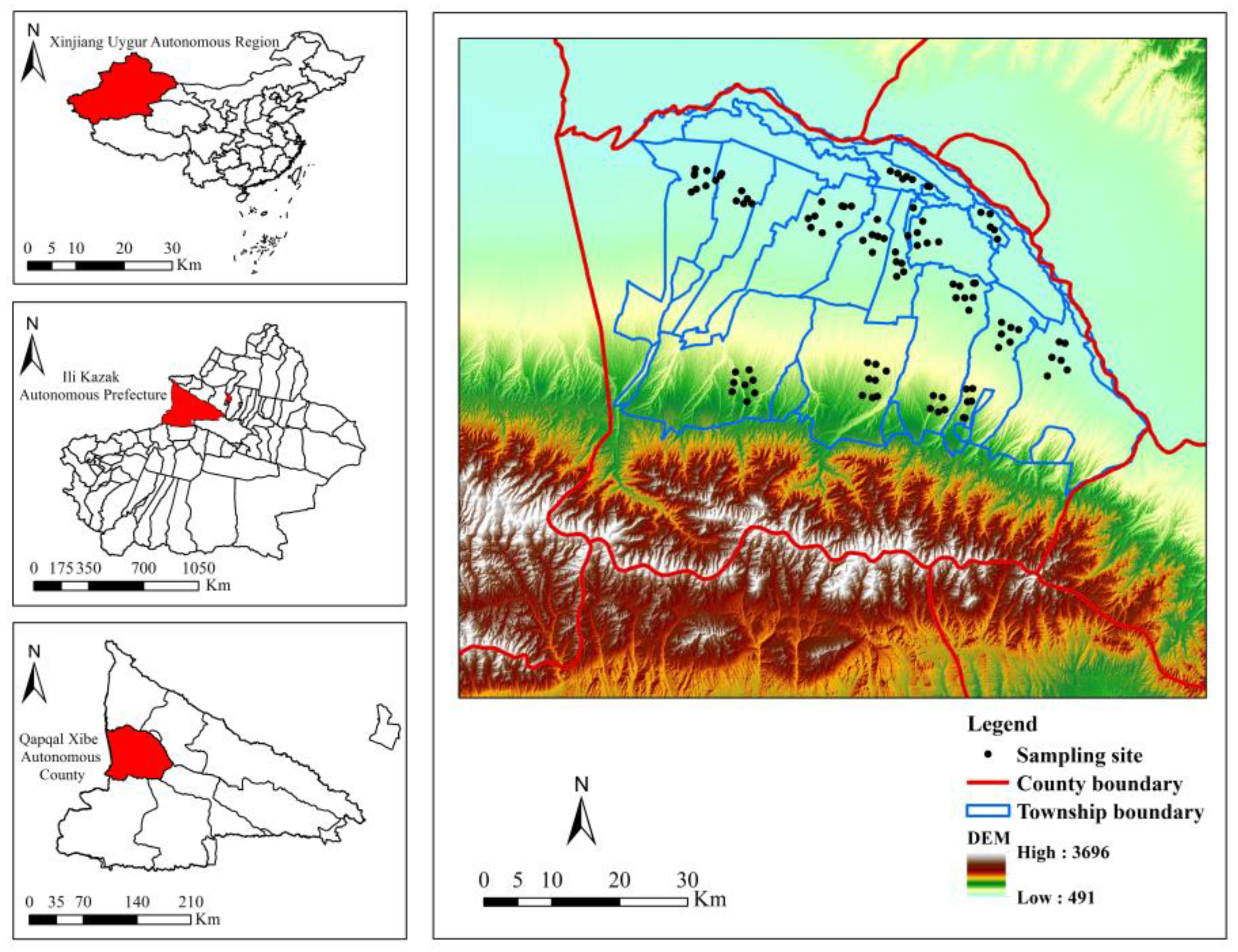
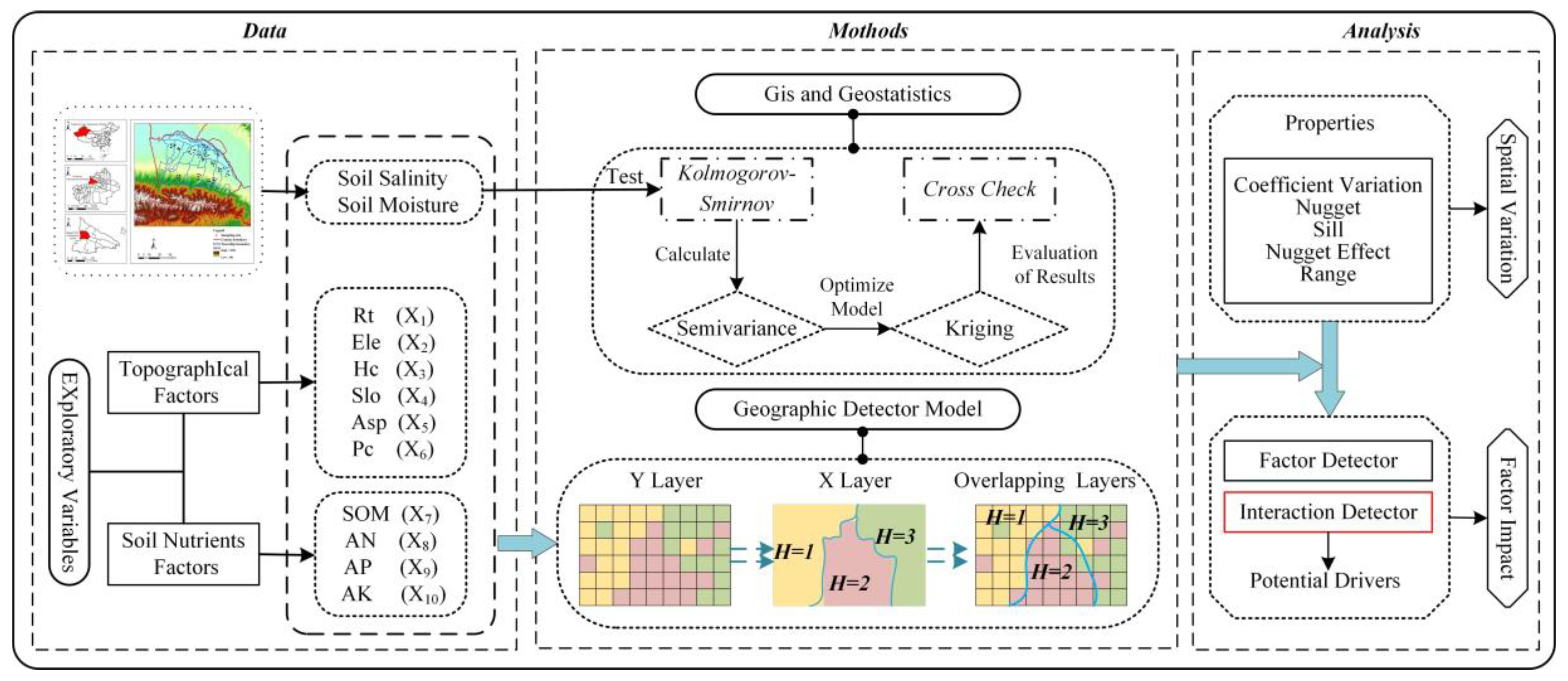
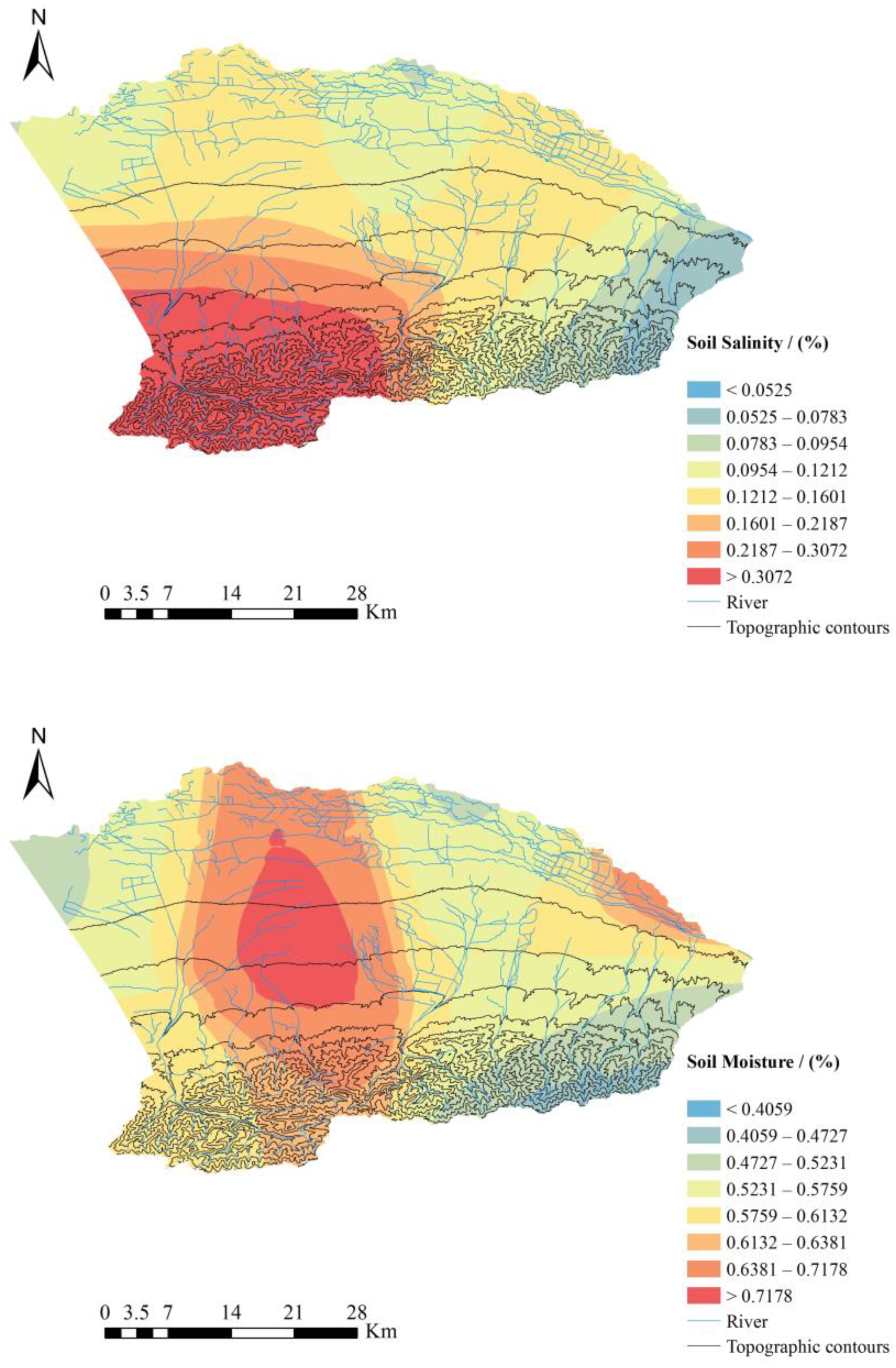
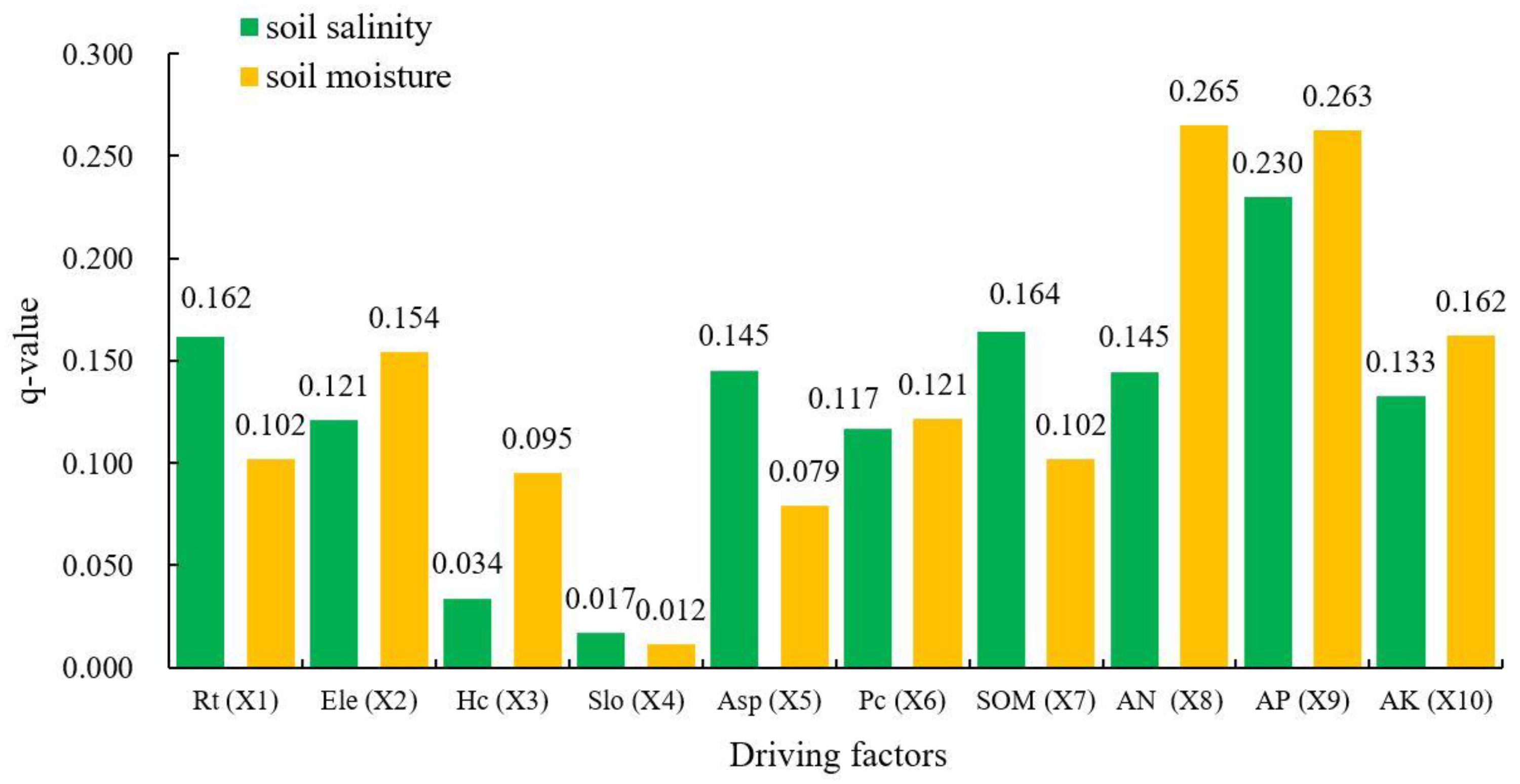
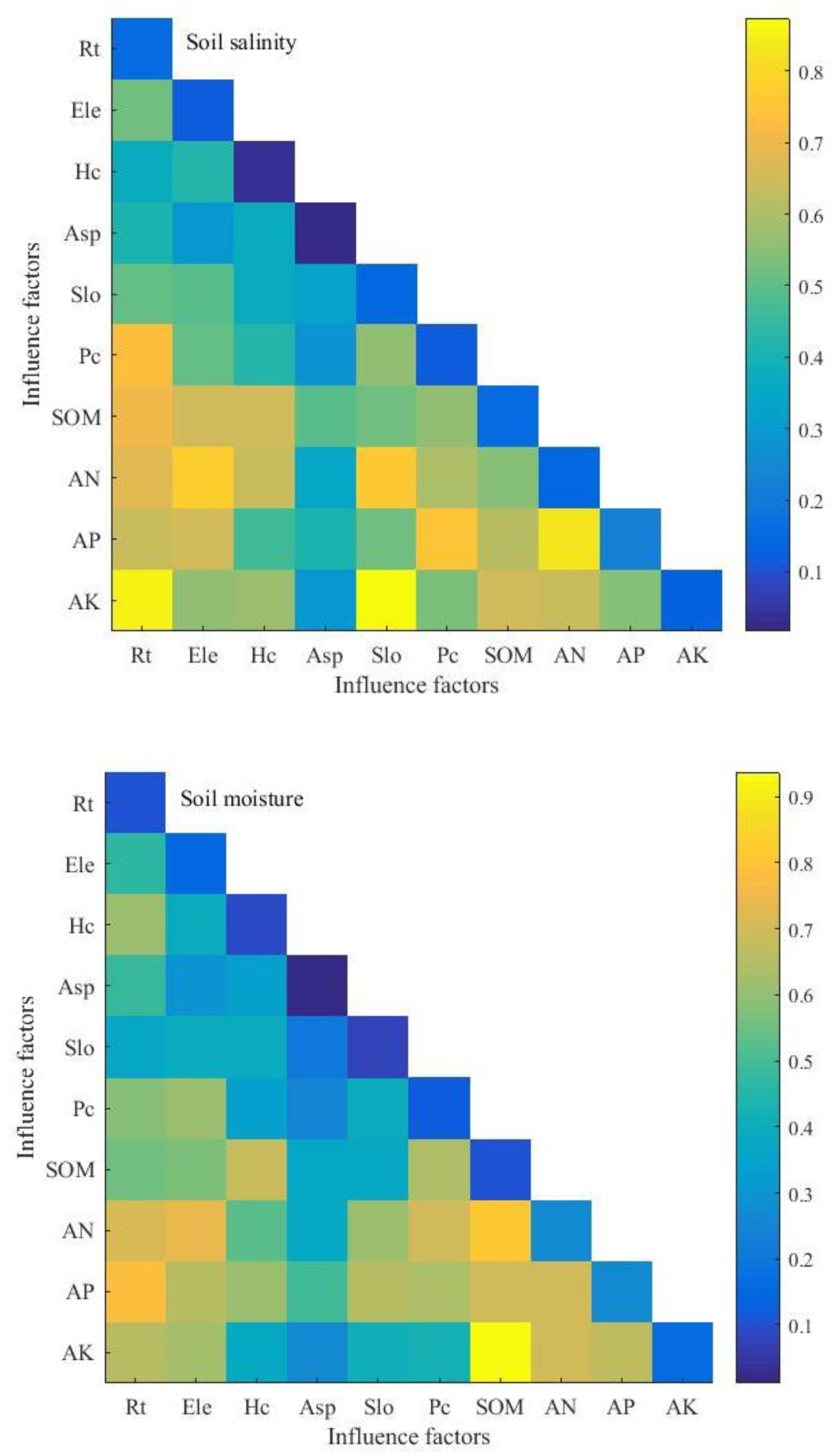
| Indicator | Mean | Standard Deviation | Variance | Maximum | Minimum | Coefficient Variation/% |
|---|---|---|---|---|---|---|
| Rt (X1) | 22.13 | 38.46 | 1479.33 | 158.00 | 2.00 | 173.79 |
| Ele (X2) | 843.50 | 433.70 | 188116.00 | 2400.00 | 575.00 | 51.42 |
| Hc (X3) | 192.10 | 116.90 | 13675.20 | 359.30 | 1.60 | 60.85 |
| Asp (X4) | 89.99 | 0.01 | 0.0002 | 90.00 | 89.94 | 0.01 |
| Slo (X5) | 174.60 | 161.30 | 26001.60 | 357.50 | −1.00 | 92.38 |
| Pc (X6) | 60.89 | 30.07 | 904.40 | 88.31 | 4.53 | 49.38 |
| SOM/(%) (X7) | 2.24 | 0.46 | 0.21 | 3.35 | 1.54 | 20.42 |
| AN/(mg·kg−1) (X8) | 134.00 | 51.61 | 2663.74 | 243.94 | 49.90 | 38.51 |
| AP/(mg·kg−1) (X9) | 10.84 | 11.18 | 125.09 | 51.99 | 2.02 | 103.14 |
| AK/(mg·kg−1) (X10) | 264.00 | 99.00 | 9793.40 | 478.80 | 66.60 | 37.50 |
| Variable | Description | Formula | References |
|---|---|---|---|
| Roughness of terrain (Rt)/m | The difference between the maximum and minimum values of the DEM grid. neighbourhood, represents the range of change in the surface elevation. | a | [46] |
| Horizontal curvature (Hc)/m-1 | A curvature of a normal section of the land surface, indicates that bending and variation of land surfaces along the horizontal direction. | b | [47] |
| Slope (Slo)/° | An angle between a tangent plane and a horizontal one at a given point on the land surface, indicates the degree of inclination of the local surface slope. | b | [47,48] |
| Aspect (Asp)/° | Indicates that there is deviation of a surface from a horizontal plane. | Asp∈ [0°, 360°] | [47,48] |
| Profile curvature (Pc)/m-1 | A curvature of a normal section of the land surface by a plane, measures the rate of change in ground elevation along the direction of maximum slope. | b | [47] |
| Mean | Minimum | Maximum | Standard Deviation | Coefficient Variation (%) | Distribution Type | |
|---|---|---|---|---|---|---|
| Soil Salinity/(%) | 0.1345 | 0.0137 | 0.4407 | 0.0958 | 71.25 | LN |
| Soil Moisture/(%) | 0.6082 | 0.2547 | 1.1980 | 0.1940 | 31.89 | N |
| Theory Model | Nugget /C0 | Sill /C0 + C | Nugget Effect /[C0/C0 + C] | Range /A0(m) | R2 | Residual SS | |
|---|---|---|---|---|---|---|---|
| Soil Salinity/(%) | Spherical | 0.0059 | 0.0144 | 0.4097 | 1010 | 0.243 | 1.064 × 10-4 |
| Soil Moisture/(%) | Gaussian | 0.0146 | 0.0352 | 0.4147 | 2390 | 0.182 | 1.713 × 10-3 |
| Prediction Error | |||||
|---|---|---|---|---|---|
| ME | RMSE | ASE | MSE | RMSSE | |
| Soil Salinity/(%) | –0.0056 | 0.0897 | 0.0741 | –0.0608 | 1.2061 |
| Soil Moisture/(%) | –0.0012 | 0.1790 | 0.1651 | –0.0255 | 1.0901 |
| Soil Salinity | Soil Moisture | ||||
|---|---|---|---|---|---|
| Interaction Factor | q-Value | Interaction Results | Interaction Factor | q-Value | Interaction Results |
| X5∩X10 | 0.874 | Enhance, nonlinear | X7∩X10 | 0.938 | Enhance, nonlinear |
| X1∩X10 | 0.851 | Enhance, nonlinear | X7∩ X8 | 0.820 | Enhance, nonlinear |
| X8∩X9 | 0.823 | Enhance, nonlinear | X1∩X9 | 0.780 | Enhance, nonlinear |
| X2∩X8 | 0.779 | Enhance, nonlinear | X2∩X8 | 0.736 | Enhance, nonlinear |
| X5∩X8 | 0.762 | Enhance, nonlinear | X1∩X8 | 0.708 | Enhance, nonlinear |
| X6∩X9 | 0.752 | Enhance, nonlinear | X8∩X9 | 0.706 | Enhance, nonlinear |
| X1∩X6 | 0.728 | Enhance, nonlinear | X8∩X10 | 0.703 | Enhance, nonlinear |
| X1∩X7 | 0.708 | Enhance, nonlinear | X7∩X9 | 0.701 | Enhance, nonlinear |
| X1∩X8 | 0.683 | Enhance, nonlinear | X6∩X8 | 0.697 | Enhance, nonlinear |
| X3∩X7 | 0.656 | Enhance, nonlinear | X3∩X7 | 0.692 | Enhance, nonlinear |
| X2∩X9 | 0.656 | Enhance, nonlinear | X9∩X10 | 0.666 | Enhance, nonlinear |
| X7∩X10 | 0.652 | Enhance, nonlinear | X2∩X9 | 0.661 | Enhance, nonlinear |
| X2∩X7 | 0.650 | Enhance, nonlinear | X1∩X10 | 0.657 | Enhance, nonlinear |
| X3∩X8 | 0.644 | Enhance, nonlinear | X5∩X9 | 0.649 | Enhance, nonlinear |
| X1∩X9 | 0.642 | Enhance, nonlinear | X6∩X9 | 0.645 | Enhance, nonlinear |
| X8∩X10 | 0.641 | Enhance, nonlinear | X6∩ X7 | 0.635 | Enhance, nonlinear |
| X7∩X9 | 0.612 | Enhance, nonlinear | X2∩X10 | 0.629 | Enhance, nonlinear |
| X6∩X8 | 0.604 | Enhance, nonlinear | X3∩X9 | 0.614 | Enhance, nonlinear |
| X3∩X10 | 0.579 | Enhance, nonlinear | X2∩X6 | 0.612 | Enhance, nonlinear |
| X2∩X10 | 0.563 | Enhance, nonlinear | X5∩X8 | 0.611 | Enhance, nonlinear |
| X6∩X7 | 0.559 | Enhance, nonlinear | X1∩X3 | 0.606 | Enhance, nonlinear |
| X5∩X6 | 0.553 | Enhance, nonlinear | X1∩X6 | 0.588 | Enhance, nonlinear |
| X7∩X8 | 0.542 | Enhance, nonlinear | X2∩X7 | 0.569 | Enhance, nonlinear |
| X9∩X10 | 0.539 | Enhance, nonlinear | X1∩X7 | 0.550 | Enhance, nonlinear |
| X6∩X10 | 0.535 | Enhance, nonlinear | X3∩X8 | 0.521 | Enhance, nonlinear |
| X5∩X9 | 0.525 | Enhance, nonlinear | X4∩X9 | 0.494 | Enhance, nonlinear |
| X1∩X2 | 0.523 | Enhance, nonlinear | X1∩X4 | 0.483 | Enhance, nonlinear |
| X5∩X7 | 0.513 | Enhance, nonlinear | X1∩X2 | 0.471 | Enhance, nonlinear |
| X2∩X6 | 0.506 | Enhance, nonlinear | X6∩X10 | 0.426 | Enhance, nonlinear |
| X1∩X5 | 0.499 | Enhance, nonlinear | X5∩X10 | 0.410 | Enhance, nonlinear |
| X2∩X5 | 0.486 | Enhance, nonlinear | X5∩X6 | 0.401 | Enhance, nonlinear |
| X4∩X7 | 0.486 | Enhance, nonlinear | X3∩X5 | 0.394 | Enhance, nonlinear |
| X3∩X9 | 0.469 | Enhance, nonlinear | X2∩X3 | 0.391 | Enhance, nonlinear |
| X2∩X3 | 0.426 | Enhance, nonlinear | X2∩X5 | 0.388 | Enhance, nonlinear |
| X3∩X6 | 0.419 | Enhance, nonlinear | X5∩X7 | 0.387 | Enhance, nonlinear |
| X1∩X4 | 0.411 | Enhance, nonlinear | X4∩X8 | 0.387 | Enhance, nonlinear |
| X4∩X9 | 0.406 | Enhance, nonlinear | X3∩X10 | 0.379 | Enhance, nonlinear |
| X1∩X3 | 0.377 | Enhance, nonlinear | X4∩X7 | 0.366 | Enhance, nonlinear |
| X3∩X5 | 0.376 | Enhance, nonlinear | X1∩X5 | 0.364 | Enhance, nonlinear |
| X3∩X4 | 0.367 | Enhance, nonlinear | X3∩X4 | 0.343 | Enhance, nonlinear |
| X4∩X8 | 0.345 | Enhance, nonlinear | X3∩X6 | 0.342 | Enhance, nonlinear |
| X4∩X5 | 0.329 | Enhance, nonlinear | X2∩X4 | 0.301 | Enhance, nonlinear |
| X4∩X10 | 0.296 | Enhance, nonlinear | X4∩X10 | 0.258 | Enhance, nonlinear |
| X2∩X4 | 0.288 | Enhance, nonlinear | X4∩X6 | 0.252 | Enhance, nonlinear |
| X4∩X6 | 0.273 | Enhance, nonlinear | X4∩X5 | 0.204 | Enhance, nonlinear |
© 2019 by the authors. Licensee MDPI, Basel, Switzerland. This article is an open access article distributed under the terms and conditions of the Creative Commons Attribution (CC BY) license (http://creativecommons.org/licenses/by/4.0/).
Share and Cite
Xu, L.; Du, H.; Zhang, X. Spatial Distribution Characteristics of Soil Salinity and Moisture and Its Influence on Agricultural Irrigation in the Ili River Valley, China. Sustainability 2019, 11, 7142. https://doi.org/10.3390/su11247142
Xu L, Du H, Zhang X. Spatial Distribution Characteristics of Soil Salinity and Moisture and Its Influence on Agricultural Irrigation in the Ili River Valley, China. Sustainability. 2019; 11(24):7142. https://doi.org/10.3390/su11247142
Chicago/Turabian StyleXu, Li, Hongru Du, and Xiaolei Zhang. 2019. "Spatial Distribution Characteristics of Soil Salinity and Moisture and Its Influence on Agricultural Irrigation in the Ili River Valley, China" Sustainability 11, no. 24: 7142. https://doi.org/10.3390/su11247142
APA StyleXu, L., Du, H., & Zhang, X. (2019). Spatial Distribution Characteristics of Soil Salinity and Moisture and Its Influence on Agricultural Irrigation in the Ili River Valley, China. Sustainability, 11(24), 7142. https://doi.org/10.3390/su11247142




